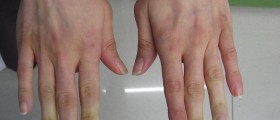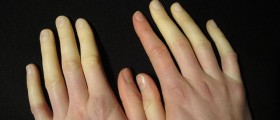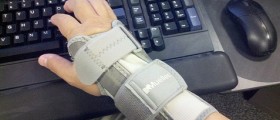
If you experience pain or numbness in your wrists, fingers, usually taking place after you have had a long career of typing, obesity or stress due to training, you are likely to suffer from carpal tunnel syndrome. This is a condition which is not yet fully understood, in terms of its pathophysiology, but is quite common in people of the above mentioned categories nevertheless.
Basically, carpal tunnel syndrome is best described as idiopathic median neuropathy, taking place at the carpal tunnel itself.
Definition and History
The carpal tunnel is located at the base of our wrists. Several tendons and the median nerve pass through this area, being surrounded by the carpal bones. Thus, the purpose of this transitional aria is to allow our fingers to move, feel and function properly.
Once the size of the tunnel decreases or the inside of it swells, the median nerve gets compressed.
Since carpal tunnel syndrome presents a pinched nerve in the wrist area, it can result in pain and discomfort which can keep a person up during the night. The main symptoms of this condition are numbness in the fingers, especially the thumb and the index finger and the radial half of the ring finger. This numbness most commonly affects people during night hours, interfering with their sleep patterns. Also, during the night, people tend to flex their wrists while they are asleep, making matters worse.
If carpal tunnel syndrome is not treated timely, it can lead to extreme numbness, making the condition unbearable and quite painful.
People started hearing and paying attention to this condition after the WWII, even though reports of this condition have been tracked in the literature of the 19th century too. Namely, in 1854, Sir James Paget reported a compression of the medial nerve. Yet, the name “carpal tunnel syndrome” was first given to this condition by a physician Dr. George S. Phalen in 1939.
Signs and Causes
The main signs of this condition in patients who have not yet had it treated are burning, numbness and tingling in the finger area. Additionally, in some cases, people may experience pain in the hands and the wrists, resulting in a decrease of their grip power.
In some cases, inflammation, edema or even hypertrophy can compress the median nerve, making people mistake their condition for the carpal tunnel syndrome.
Many times, the causes behind carpal tunnel syndrome are unknown. However, there are certain conditions which are known to contribute to the development of this health problem. Some of these are obesity, usage of oral contraceptives, hypothyroidism, diabetes, arthritis and traumas. Hereditary neuropathy can trigger this condition too, along with tumors, lipomas, vascular malformations and ganglions.
One's line of work may be the main reason behind the carpal tunnel syndrome. Basically, being involved in repetitive tasks which require using your fingers or hands, along with your wrists continuously, all can lead to the development of this condition.
Usually, when people are diagnosed with carpal tunnel syndrome, they are allowed to take time off, resulting in about $30,000 spent yearly on treatment and time off work.
Statistically, carpal tunnel syndrome is mostly diagnosed in adult people who work, even though the condition is seen in people who are unemployed and older. Also, despite of claims that this condition is triggered by repetitive manual labor, there are individuals and groups saying that CTS is caused by genetic factors only. Thus, this condition is often a matter of controversy.
Treatment
Resting and allowing your carpal tunnel to recover is the best common way of treating this condition. Yet, among other accepted forms of treatment, splinting or bracing, injecting steroids, changing your daily activities, undergoing physiotherapy or massage therapy, taking different medications, visiting a chiropractic or having a surgery done are all possible ways of dealing with carpal tunnel syndrome.
If a single method of treatment fails to help the patient within 2 to 7 weeks, he/she is exposed to a different one instead. Also, the treatment may vary, depending on the underlying cause since the cause itself is treated when it is known. In general, people are reluctant to settle for splints or braces. Therefore, these are effective, but less common ways of treatment.
Today, 7% of the total population suffers from musculoskeletal disorders including carpal tunnel syndrome. Only in 1994, according to research, about 849,000 of new carpal tunnel syndrome cases appeared. The condition is blamed for 260,000 surgical interventions each year and 47% of cases of work-related carpal tunnel syndrome.
All in all, this is a health condition getting more and more present in the human race, especially in the modern era of computers, cell-phones and excessive, repetitive usage of our fingers and hands in general. It manifests through a compression of the median nerve in our wrists due to various factors and can be treated in many different ways, depending on the underlying cause of it.
Thus, if you notice the symptoms of this condition, do not wait for it to get worse. Rather, pay your physician a visit and have carpal tunnel syndrome either diagnosed and treated or ruled out.

















Your thoughts on this
Loading...